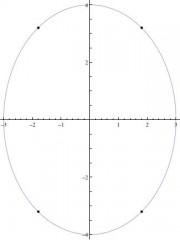If x and y are functions of time (t), the derivative with respect to t is
2*16*x*x' + 2*9*y*y' = 0
If x' = ±y', then
±16x + 9y = 0
x = ±9y/16
Plugging this into the equation for the ellipse, we get
16*(9/16y)^2 + 9*y^2 = 144
y^2 = 144/(9^2/16+9) = 10.24 = 3.2^2
y = ±3.2
x = ±9/16*y = ±1.8
The four points where the slope is ±1 are (±1.8, ±3.2).
 If you insist that the rates of change actually be equal, rather than just of equal magnitude, then this will only occur at the two points
If you insist that the rates of change actually be equal, rather than just of equal magnitude, then this will only occur at the two points
(x, y) = (-1.8, 3.2) or (1.8, -3.2),
that is, those points where the slope is +1.
2*16*x*x' + 2*9*y*y' = 0
If x' = ±y', then
±16x + 9y = 0
x = ±9y/16
Plugging this into the equation for the ellipse, we get
16*(9/16y)^2 + 9*y^2 = 144
y^2 = 144/(9^2/16+9) = 10.24 = 3.2^2
y = ±3.2
x = ±9/16*y = ±1.8
The four points where the slope is ±1 are (±1.8, ±3.2).

(x, y) = (-1.8, 3.2) or (1.8, -3.2),
that is, those points where the slope is +1.